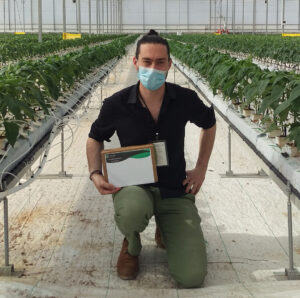Disease detection is in the air

New technology is being developed that can collect crop pathogen microorganisms for DNA analysis, from the air and more.
Genetic sequencing of field crop and greenhouse disease pathogens has only been available for a few years – but first you must have a sample of the pathogen in question.
Getting those samples is easy if you are using plant tissue, but it would be very valuable for crop producers to see what pathogens are in the air, water or on surfaces before the pathogen makes it into the plant.
DNA samples
Rémi Maglione, co-founder of an Ontario, Canada-based firm called Harvest Genomics has developed a proprietary method of taking DNA samples from plant tissue, but also from swabs on greenhouse surfaces, including plant leaves, counters, floors and so on.
Maglione has also developed a way to increase the virus fraction in water samples in order to detect water-borne viral diseases in greenhouses, and other settings.
In terms of plant tissue, water and surface samples taken using Harvest Genomic technology (and note that the genetic sequencing of the DNA in the samples is done using a small device made by a British company named Oxford Nanopore) were tested and found to be completely accurate in 2021 by the Ontario Greenhouse Vegetable Growers and the Ontario Ministry of Agriculture, Food and Rural Affairs (OMAFRA).
After the DNA in the samples are analyzed, the results tell you whether you’ve got a viral or bacterial disease in your greenhouse or field, and which one. Analysis of samples from surfaces in a greenhouse can also help determine whether sanitation procedures are working, and whether a new sanitation product is doing a good job.
Current commercial work
Presently, Harvest Genomics mostly analyzes tomato plant tissue, water, and swabs samples for the presence of tomato brown rugose fruit virus (ToBRFV), commonly called rugose.
About 3,000 samples were tested for rugose for greenhouse customers in Canada and the US in 2021. This year, the same rate of between 100 to 200 tests a month is continuing.
The company has results back to clients in two days at about €116 per sample.
Air samples

Currently, Maglione and his colleagues are hard at working on a new version of the proprietary sampling technology, one that traps pathogens and all other biological materials from the air.
“It uses a small vacuum, and we are testing several filters and types of reagents to see what is best,” he says. “These include different types of tape, gels or liquids.”
Maglione is confident that by the end of the year, it will be clear which reagent or filter works best. Field tests of the device will begin in mid-September likely in both a horticultural crop field and in a greenhouse setting.
“We will then work to commercialize the protype in partnership with engineers in order to make sure the design is as easy to manufacture as possible in terms of 3D printing and other manufacturing processes,” he says.
To help Maglione and his colleagues develop this air sampling technology straight to a portable version, Harvest Genomics applied for funding from a government agency called BioEnterprise Canada, and in April received €31,000.
When the portable device is commercialized, it will be able to be purchased and used by horticultural farmers, greenhouse operators, consultants and more.
“I believe it will also open up new possibilities for researchers as well,” says Maglione, “which is very exciting. Not just in relation to research on crop disease but also in many other sectors, for local and global bio-surveillance. We are very pleased that our sampling technology has so many possibilities and we hope it will make a very big impact in terms of research and also practical uses in many locations, such as greenhouse, forest, urban settings and more.”
Portable genomic platform
At the same time Harvest Genomics is developing a portable air sampling device, it is also developing an entire portable lab system.
“We call it a ‘point-of-farm’ system, and it will make it possible to do any kind of molecular-based genetic sequencing tests right on the farm,” says Maglione.
Before the pandemic, there was interest from various groups in a portable version of the genomic technology.
“That interest was of course intensified by the pandemic,” says Maglione. “We made a lot of progress on the portable platform last year. Our CEO and co-founder Chris Grainger worked with OMAFRA and the Ontario Potato Board for identifying variants of Potato Leaf Blight captured on spore-trap devices placed in potato fields, and a beta-version of the portable genomic platform was developed.”
Join 17,000+ subscribers
Subscribe to our newsletter to stay updated about all the need-to-know content in the agricultural sector, two times a week.



